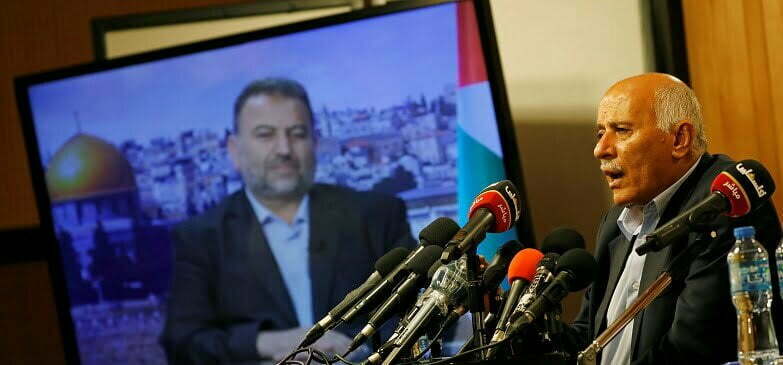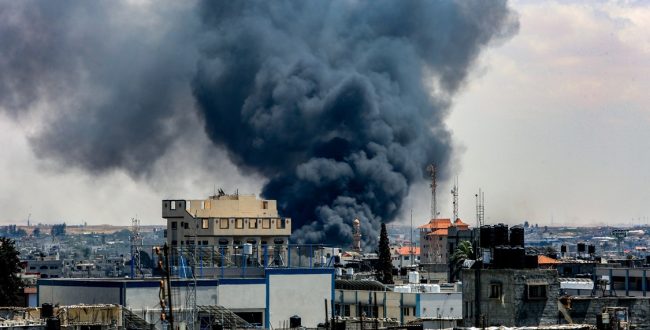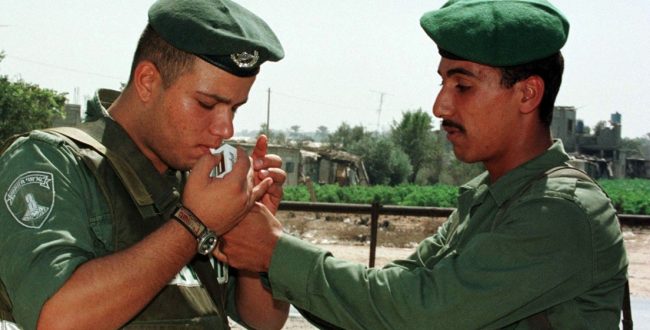The many blows that the Palestinians have received over the past few months has created huge and weighty challenges for their leaders; challenges that require different treatment than in the past. The publication of the Trump Plan last January, the annexation plan announced by Prime Minister Netanyahu, and the agreement for establishing normal relationships between Israel and the UAE and Bahrain, which, in the meantime, has pushed off the annexation: all of these have forced Fatah and Hamas, and other factions closer to one another in the face of the threat that stems from these developments. It is a threat to their Palestinian identity, the exclusive right to represent it, and the best way to reach a solution to the Palestinian issue. The normalization agreement was the straw that broke the camel’s back, because it threatens Arab support of Palestine which is the foundation of the Palestinian fight against Israel, and expropriates their right to exclusive representation that they had worked towards for so many years. The refusal of the Arab foreign ministers to condemn the deviations from the principles of the Arab Initiative within the normalization agreement, during the Arab League Conference on September 9th simply added to this feeling.
Since then, the Palestinian camps have been trying to promote understandings and agreements between themselves as the necessary and up to date infrastructure of a strategic consolidation in the fight for a Palestinian nation while facing the changing reality of a unprecedent strategic low in Palestinian history.
A meeting held by Fatah and Hamas, led by the two senior officials from both sides, Jibril Rajoub and Saleh al-Arouri, in Istanbul on the 24th of September. This is another event in a series of events which demonstrate the attempts to promote reconciliation, a shared fight, or at the very least, the appearance of unity among the ranks of the Palestinian camp. The conference was preceded by a joint press conference held by Rajoub and al-Arouri is an expression of the grave importance that the Palestinian sphere considers these latest developme beginning of August, the former from his residence in Ramallah, and the latter from his residence in Beirut, as well as an unprecedented, meeting of all three heads of the Palestinian factions on the 3rd of September, headed by President Abbas. The meeting was also held in those two locations, and at the end of it Fatah and Hamas representatives agreed to draw up a joint plan to deal with the new challenges. In addition, Ismail Haniyeh, the head of Hamas’s political arm, appeared on the P.A Palestine television channel, and Jibril Rajoub appeared on Hamas’s television channel, Al-aqsa. Likewise, the rhetoric being used by the two sides demonstrates that the two are becoming closer and are willing to come to an agreement.
The meeting in Istanbul ended with an agreement to hold elections for the Palestinian institutions, but it still requires the approval of the two organizations and the approval general assembly of all the organizations. On October 1st, Fatah’s central committee approved the understandings.
These are unprecedented developments in the Palestinian sphere. The many reconciliation attempts between the two faction, have up until now, been mediated by an Arab country, usually Egypt, and sometimes, additionally, the encouragement of a non-Arab figure. This time the reconciliation attempt has come from within the Palestinian sphere, and it is these two organizations who are leading it. They both perceive the Palestinian cause to be at an unprecedented low, which places it at a historical moment requiring decisions that are different to those that have been made in the past, decisions that will offer a Updated way of dealing with the challenges of the times. The assumption that stands behind these unification attempts, is that both Fatah and Hamass’ strategies are not enough to free the Palestinian nation from its troubles on their own.
In the background of all this, stands the Trump administration, which, from the time it entered the White House, has made prominent changes to the United State’s approach to the solution to the conflict. Trump is trying to force a permanent agreement on the Palestinians that no Palestinian organization could accept, and the Arab countries that are close to the United States can’t stand up to his pressure. Some of have even taken action vis-à-vis the Palestinians thatserve his administration. Israel enjoys broad American backing, which has made it possible for it to establish facts on the ground, without the contingencies of an agreement between the sides. The Trump plan for the solution of the Israeli-Palestinian conflict which was published last January, has caused the two Palestinian factions to stand united against him, because it does not address even the most minimum of requirements of the most moderate factions in the Palestinian sphere.
It has been interpreted as clearance for Israeli annexation of all the territory between the Mediterranean and the Jordan River due to the security authority it gives to Israel even after the establishment of a Palestinian state, as well as due to the fact that it allows jurisdiction over the holy places in East Jerusalem, etc. And if that is not enough, then came the normalization agreements with the UAE and Bahrein which made it clear to the Palestinians that the annexation, which the UAE had been proud of cancelling, had been delayed and not cancelled. Prime Minister Netanyahu has clarified again and again, that annexation has not been cancelled, but delayed, and that he intends to it carry out. The Trump administration has not made any indication that it disapproves of Netanyahu’s statement.
However, it is not clear to what extent the two Palestinian factions will be able to move towards each other, modify their basic positions, and put aside their unique interests in order to work together as one body. The widespread assumption among both sides is that the very fact of their attempt to come together is a response to public demand. The Palestinian public perceives the gap between them as the primary reason for Palestinian weakness, making it possible for any and every foreign body to come between them. If they are successful in closing the gap, Fatah and Hamas will affect the other factions. Of course they must deal with a number of familiar roadblocks which they have dealt with over the course of the many attempts at reconciliation over the years. Here are three
examples:
Armed resistance and Weaponry
When Abu Mazen was elected president in 2005 he put a stop to all types of violence in the fight against Israel, and announced the beginning of a new era- the era of the “Great Jihad”, as he called it- of internal and independent work; an era that includes full security coordination with Israel, which he has characterized as holy. In this way, with time, Abu Mazen has delegitimized armed battle against Israel in the West Bank. The Hamas takeover of the Gaza Strip in 2007 created a separation between the two areas, which made it easier for Abu Mazen to maintain the security coordination and the quiet all over the West Bank. Since then he has demanded that the PA have control over the armaments as a condition for any reconciliation. Hamas refused this demand and continues to see armed resistance as one of its main methods, though over the last few years, in light of the hard hits it has taken, it has made its position a bit more flexible. Hamas published a new policy platform in 2017, which could make it possible to create a mechanism for joint non-violent action against Israel, though not necessarily in the framework of full reconciliation.
The Inter-Organization Balance of Powers
On the Israeli side, the widespread assumption is that Hamas is a more coherent, and stronger body with a defined ideology that does not recognize Israel and its right to exist, and that is imbued with the belief in the rightness of its path. There are two aspects that influence this image: one is the message that Israel puts out regarding each of these organization, which very much effects the organization’s internal status; and the second is the fact that the Palestinians see resistance as the height of sacrifice and as a way to release feelings of rage and revenge, but do not necessarily believe that it is enough to advance liberation and influence Israel’s core principles. Proof of this is the marked decrease in armed resistance from Gaza since 2014. Hamas is well aware of the fact that its continued existence in the Gaza Strip is the result of an Israeli decision not to re-conquer the Gaza Strip, and that the balance of powers in favor of Israel is huge. The many claims that it deters Israelis are, to a great extent, a result of Israeli public discourse, which reinforces those claims. Therefore, it is very hard to say that today the inter-organizational relationship is a zero sum game. Hamas is more aware than ever of the need to work together, and the need to become part of the international community.
One should remember that even if it takes over the PLO, in the end Hamas will need to deal with more complicated issues than these, issues that it does not have the ability to deal with in the Gaza Strip today- could Hamas ignore the presence of Israel in the West Bank? Would it be able to gain the support of, or any type of aid from any European body without Fatah as a central member of the PLO; and if and when Hamas takes over in the future, would it join the radical branch and endanger itself with a continuous conflict with Israel and delegitimize itself in the perception of a large part of the Palestinian nation?
Joining the Turkey-Qatar Axis
On the face of it , that Hamas and Fatah have become closer to this axis. However, in terms of Fatah, this closeness has far reaching consequences- not because of the distance between it and Turkey and Qatar, in fact, the opposite, it has a fine relationship with Qatar, and there have been no problematic incidences with Turkey, but rather, due to the price that is inherent in abandoning the other, more moderate, more national, and less Islamic camp to which it had always belonged. Therefore Fatah’s relationship with this axis is a type of protest against western policy which supported the normalization with Israel, more than it is an attempt to separate from the moderate camp. Jibril Rajoub and Rauhi Fatukh, Fatah senior officials, were quick to jump from Istanbul to Cairo in order to assure Egypt that their place in Palestinian dialogue still remains, and that the difference now is in the fact that this time it is an internal Palestinian initiative. This is why ignoring the moderate axis could be a roadblock to the reconciliation efforts. Fatah cannot give up its relationship with this camp, despite its disappointment with it, and Hamas, which identifies with the Turkish-Qatari axis has already made efforts to get closer to those countries, unsuccessfully.
All of this brings to light the great complexity of the Palestinian sphere. The question is whether these two camps see the urgency of this time, eye to eye; whether they do indeed think that there is a clear and present danger to the Palestinian cause, and whether they are indeed interested in a full national reconciliation or a bilateral agreement regarding division of power. it is more likely that there is no one opinion, and that no one that has any hope in external developments that will undo the negative trends that the Trump administration has initiated, such as the elections in the United States, the results of which could change regional American policy, and the pressure on the Arab regimes to pacify the president sitting in the White House. Therefore it is better to speak of an effort to come to a reconciliation and to reach results that do not necessarily express reconciliation but rather closeness or management of the gap. This sort of situation would also create an unprecedented reality for those within the Palestinian world.
















